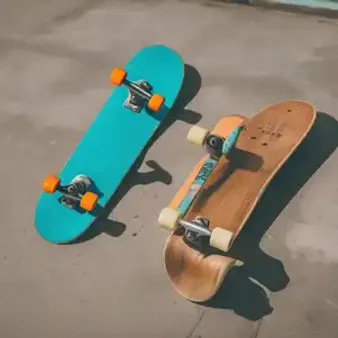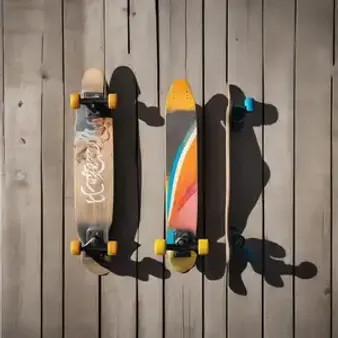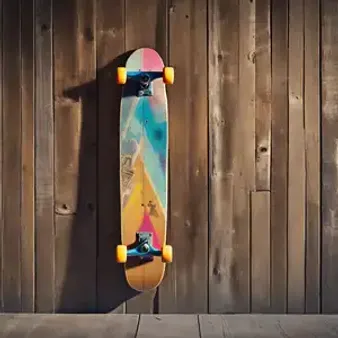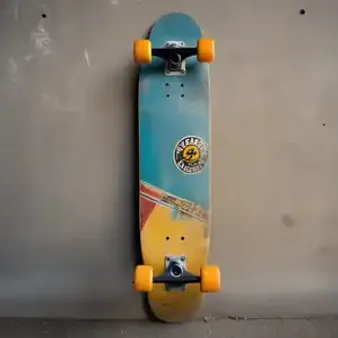Table of Contents
Remember the simple thrill of cruising down the sidewalk on a skateboard? Those boards weren't just toys; they were pieces of history in the making. Today, antique skateboards offer a fascinating glimpse into skateboarding's past and have become highly sought-after collectibles. At kizworld, we're passionate about exploring the world of vintage treasures, and antique skateboards are no exception. Join us as we ride through the history, identification, value, and care of these iconic pieces.
Feature | Description | Example |
|---|---|---|
Decks | Early decks were often made of simple wood planks, sometimes with metal plates or clay wheels. | 1960s Roller Derby Surfboard |
Trucks | Early trucks were rudimentary, often adapted from roller skates. | Chicago Trucks |
Wheels | Early wheels were typically metal or clay, later evolving to polyurethane. | Road Rider wheels |
Brands | Look for iconic brands like Makaha, Hobie, and Roller Derby. | 1970s Dogtown Z-Boy board |
Condition | Condition significantly impacts value; pristine boards are highly desirable. | Mint condition Roller Derby board with original box |
The History of Antique Skateboards: From Wooden Planks to Urethane Wheels
The Early Days: From Sidewalk Surfing to Clay Wheels
Imagine this: it's the 1950s, and surfers in California are itching to catch a wave, even when the ocean is flat. That's how skateboarding was born! The earliest skateboards were literally just wooden planks with roller skate wheels attached. Can you imagine trying to steer one of those? These "sidewalk surfers" quickly caught on, and soon kids everywhere were crafting their own boards. They even started experimenting with different materials, like metal plates for decks and clay for wheels. Can you imagine how bumpy that ride must have been? It wasn't exactly a smooth ride, but those early pioneers were paving the way for the skateboarding we know and love today.
- How to Get Started with Skateboarding as a Beginner
- How to Choose the Right Skateboard for Your Skill Level and Style
- The History and Culture of Skateboarding
The Evolution of Cool: From Steel to Urethane
Fast forward to the 1960s, and skateboarding got a major upgrade! Companies like Roller Derby started mass-producing skateboards, making them more accessible and affordable. These boards were still pretty basic, usually made of wood with steel wheels. But then came the game-changer: urethane wheels. Urethane was a softer, smoother material that revolutionized the skateboarding experience. Suddenly, riders could roll over cracks in the sidewalk, carve smoother turns, and even attempt tricks. It was like night and day! This innovation marked a turning point, pushing skateboarding beyond just a fad and into a whole new realm of possibility.
Material | Pros | Cons |
|---|---|---|
Wood | Classic look, durable | Can be heavy |
Metal | Sturdy, unique aesthetic | Can be slippery, less common |
The History of Antique Skateboards: From Wooden Planks to Urethane Wheels
Identifying an Antique Skateboard: What to Look For
Picture this: you're rummaging through your grandpa's attic, and bam—you stumble upon a dusty old skateboard! Could it be a hidden treasure? Well, here's the detective work to find out. First, check out the deck. Early boards were often simple wood planks, maybe even with cool metal plates bolted on. Later, you started seeing brands like Makaha and Hobie, which are like finding a vintage comic book! Next up, take a peek at the trucks—those metal parts that hold the wheels. Early trucks were pretty basic, sometimes even borrowed from roller skates! Over time, they got fancier, with brands like Chicago Trucks becoming all the rage. And speaking of wheels, those are a dead giveaway! Early ones were metal or clay (imagine the bumpy ride!), but then came the game-changer: urethane. If your board has those smooth, colorful wheels, you might be holding a piece of skateboarding history! For more skateboard-related fun, check out this article on how to get started with skateboarding.
Part | Early Features | Later Features |
|---|---|---|
Deck | Wood planks, metal plates | Branded decks (Makaha, Hobie) |
Trucks | Basic, roller skate-derived | Specialized trucks (Chicago Trucks) |
Wheels | Metal, clay | Urethane |
Identifying an Antique Skateboard: What to Look For
Caring for Your Antique Skateboard: Tips and Tricks
Think of your antique skateboard like a cool, old comic book. You wouldn't leave it out in the rain, right? Just like that prized comic, your board needs some TLC to stay awesome. Keep it dry and out of direct sunlight—too much sun can fade those groovy colors and warp the wood. Dust it off gently with a soft cloth, and if you're feeling brave, you can even use a little bit of wood polish to make it shine! For more awesome skateboarding tips, check out this article on how to choose the right skateboard. Remember, the better you care for your antique skateboard, the longer it can shred through the years—well, maybe not literally shred, but you get the idea!
Don't | Do |
|---|---|
Leave it in direct sunlight | Keep it in a cool, dry place |
Use harsh chemicals | Dust it gently with a soft cloth |
Caring for Your Antique Skateboard: Tips and Tricks
The Allure of Antique Skateboards: Why They're More Than Just Old Toys
Imagine holding a piece of skateboarding history in your hands! That's what it feels like to own an antique skateboard. They're not just old pieces of wood and metal—they tell a story about how skateboarding went from a simple sidewalk pastime to the global phenomenon it is today. Think about it: those faded decks and rusty trucks witnessed the birth of ollies, kickflips, and maybe even a few epic wipeouts! Each scratch and scuff mark is like a signature from the past, connecting us to the pioneers who paved the way for modern skateboarding. For more about the evolution of skateboarding, check out this article on the history and culture of skateboarding.
Decade | Popular Skateboard Styles |
|---|---|
1950s | Wooden planks with roller skate wheels |
1960s | Mass-produced boards with steel wheels, later urethane wheels |
1970s | Shorter, wider boards for better maneuverability |
Plus, let's be real—antique skateboards are just plain cool! They have a unique, vintage vibe that you can't find in a brand-new board. It's like finding a classic car in your grandpa's garage—it's got character, history, and a story to tell. Some collectors even display their antique boards as works of art, and who can blame them? Those colorful graphics, retro logos, and weathered finishes are like snapshots of a bygone era. Whether you're a seasoned skater, a history buff, or just appreciate cool stuff, antique skateboards offer a fascinating glimpse into the past. To learn about iconic skateboard brands, read this article on famous skateboarders and legends.
The Allure of Antique Skateboards: Why They're More Than Just Old Toys 
Final Thought
Antique skateboards are more than just old pieces of wood and metal; they're tangible representations of a sport's evolution and a culture's creativity. Whether you're drawn to their historical significance, unique designs, or investment potential, exploring the world of antique skateboards is a rewarding journey. So, grab your magnifying glass, dust off those old boards in the attic, and who knows, you might just have a piece of skateboarding history in your hands!